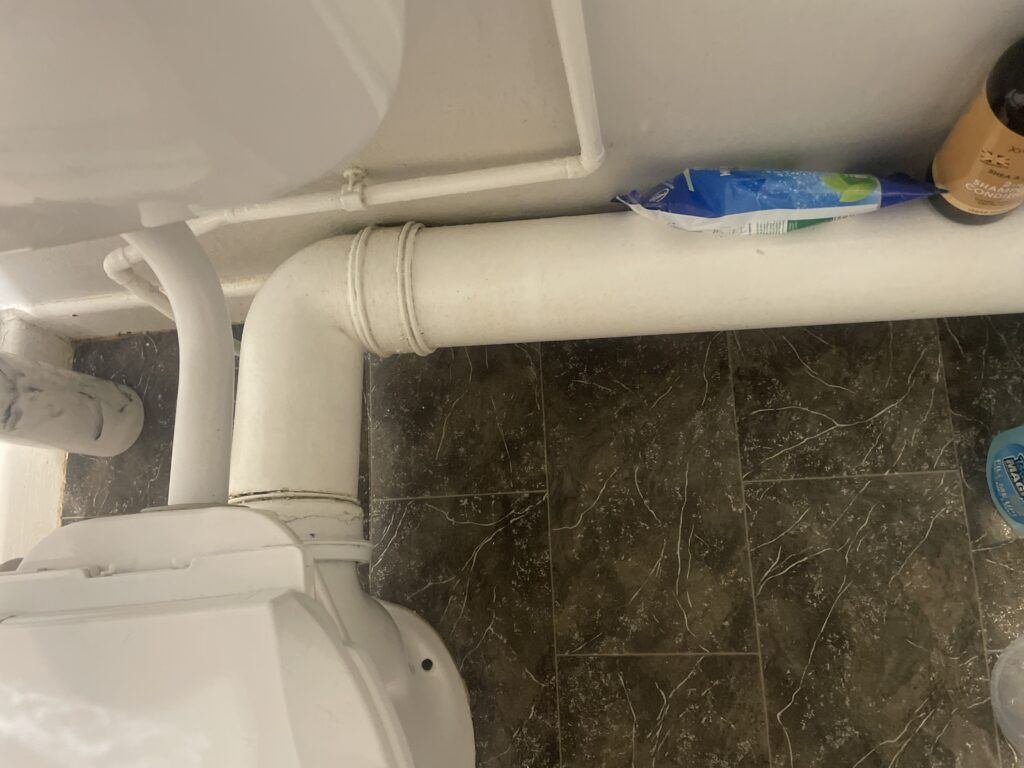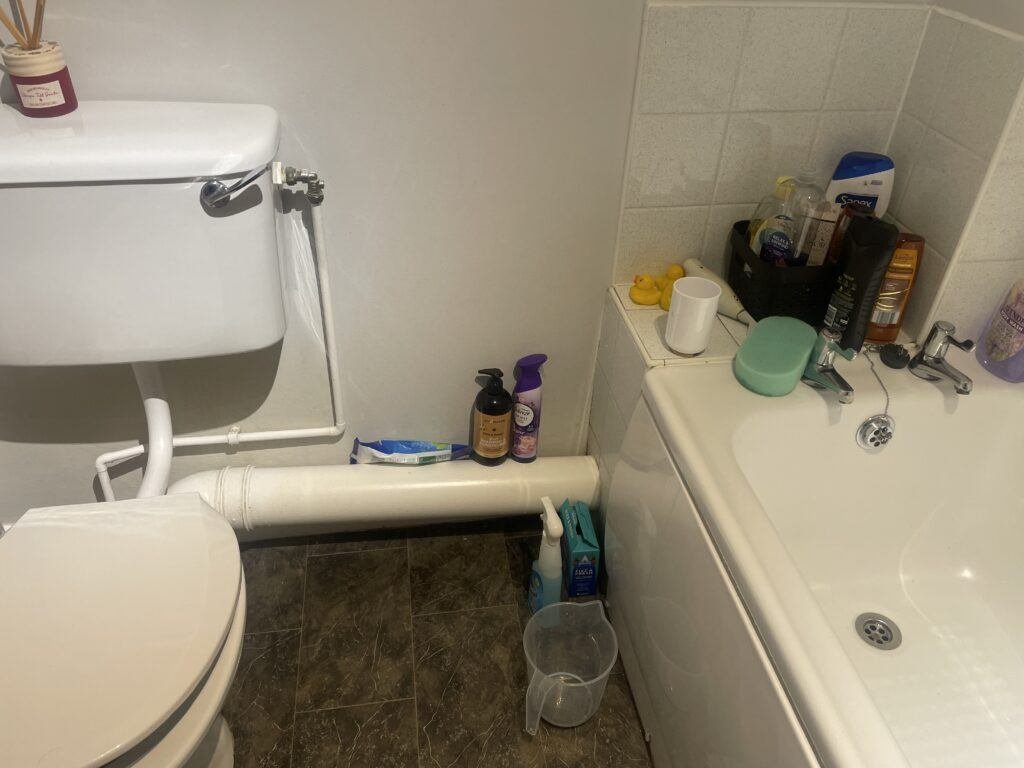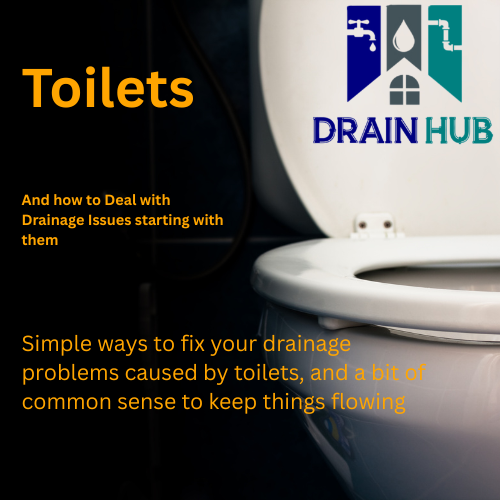Understanding toilet drainage issues from blockages to poor flow – your complete guide to diagnosis and solutions
Toilet drainage problems are among the most common and frustrating issues UK homeowners face. As a drainage engineer with 20 years of experience, I’ve seen every type of toilet blockage and flow problem imaginable. Most toilet drainage issues stem from problems in the first few metres of pipework, particularly in the U-bend and initial connecting pipework to your soil stack.

A prime example of where problems can start, a relatively flat waste pipe to the first 90 degree bend…

And then poor fall (or gradient) from the toilet to the stack in the corner, under the bath.
Common Toilet Drainage Problems I’ve Found over the Years
Blockages in the Toilet U-Bend
The Problem: The toilet’s internal U-bend (trap) is where most blockages occur. This curved section maintains a water seal to prevent sewer gases entering your home, but its tight radius makes it prone to blockages.
common causes of toilet blockages
Wet wipes and “flushable” products:
Despite marketing claims, these don’t break down like toilet paper. A lot of wet wipe packaging now proudly declare they are “flushable,” but in my experience this is nonsense as they many technically flush down the toilet, but they don’t break up like normal toilet paper and catch on obstructions such as displaced joints, stall in pipes without much gradient and just generally become a nuisance.
Whether it’s a single wipe occasionally, or bundles all the time, these very often are the primary cause of toilet blockages, and can also cause quite substantial external blockages, too (for example, check out our guide on old Victorian drains, specifically the Buchanan Trap).
Excessive toilet paper:
Particularly thick or quilted varieties. When combined with eco flushes, or weak flushes (same thing, as far as I’m concerned), this just becomes a thick, mushy mass that can form anywhere between the back of the toilet or inside the chamber of an external drain.
Sanitary products:
Should never be flushed but often are. Weirdly enough, I found these flushed pretty much equally between homes, public toilets and work bathrooms, such as office blocks or factories.
Whether bins were provided or not, some were flushed – and much like wipes, these will catch wherever they can and start the build up toward a blockage.
Children’s toys or objects:
Accidentally dropped items. These tend to go one of two ways…
Easiest way to clear is often to push the obstruction further down the system until it reaches the next manhole or drain chamber – just make sure you safely open the chamber first and leave something in the outlet to catch it; a plunger attached to a rod or a pair of small gully grabs does the trick – also, gully grabs mean you can easily retrieve the offending item.
Hard water limescale buildup:
Reduces effective pipe diameter over time, also creates a “rough edge” to the internal surface area, catching paper and other solids.
The drainage system itself:
With new builds, almost all simple toilet blockages I attended were due to a combination of a preformed external inspection chamber catching paper (it was always to code and a product they were supposed to use), a slight bend in what should be a straight line from the toilet to the external drainage, and an eco-flush.
This meant the clearances were relatively easy to find and clear, but without making changes to the plumbing or drainage, the tenant or homeowner was stuck with the inconvenience of repeat blockages for the foreseeable future.
warning signs that your toilet is blocked (or starting to back up)
- Water level rises when flushing then drains slowly
- Gurgling sounds during or after flushing
- Toilet paper doesn’t clear on first flush
- Unpleasant odours indicating poor drainage
Easy Fixes to Ongoing Toilet Blockages
Aside from the immediate fixes of not using inappropriate, non-flushable items, here are some easy, relatively cheap long term fixes you can carry out if you’re DIY savvy, or ask a plumber/drainage contractor to do for you:
Weak Flush and Insufficient Water Volume
The Problem
Modern water-saving toilets and eco-flush mechanisms sometimes don’t provide adequate water volume to clear waste effectively through the drainage system.
Common Causes:
- Dual-flush mechanisms set too low:
Water-saving settings insufficient for solid waste or heavy usage (large amount of people in the property per toilet).
I know some Water Authorities provide or install bags designed to site in a toilet cistern, reducing the water capacity per flush. Whilst in principle, this does save water – I don’t think they’re appropriate to be used in drain systems which suffer ongoing blockages; quite often the more water used in drains with poor fall, or many bends and otherwise complicated systems, the better as it keeps things moving. - Sticky flush valve:
Not opening fully or closing too quickly can result with the same as the above, not enough water.
A flush valve, or water inlet valve, is a relatively simple contraption, but can become faulty for a couple of reasons… If not replaced over a couple of years, the diaphragm can deteriorate or scale can build around it, making it difficult to function properly – the flip side of this can also be that the toilet continuously flows, where the seal cannot close back again. - Blocked rim jets:
If you find yourself having to remove scale from the toilet bowl frequently, or your taps have scale forming around them as a result of local hard water, this could also cause limescale blocking the holes under the toilet rim, effectively reducing the amount of water that can flush between cistern and toilet. - Worn internal mechanisms:
Old or damaged flush components should be a simple fix for a plumber or handyman, and will ensure a decent flush – if the underlying problems with blockages was just a weak flush, this should be a very cost effective solution. - Low water level in cistern:
An incorrectly adjusted float valve can also be a cause of a weak flush, and very simple fix – simply adjust to maximise your flush. Some allow you to adjust by hand, some may need a small screwdriver.
How this can Impact your Drainage System if not Addressed:
- Insufficient water velocity to push waste through bends
- Waste doesn’t travel far enough to reach main drainage
- Partial blockages develop over time
- Increased risk of backup into toilet bowl
- Bad smells
Poor Fall (Gradient) in Connecting Pipework
The Problem
The pipe connecting your toilet to the main soil stack must have the correct gradient (fall) to ensure gravity drainage works effectively. Building Regulations specify minimum gradients for different pipe diameters, found below:
Technical Requirements:
- 100mm soil pipes: Minimum 1:40 gradient (25mm fall per metre)
- Maximum gradient: 1:9 to prevent self-siphonage
- Pipe supports: Every 2 metres to prevent sagging
You don’t necessarily need to be a plumber or builder to fix this, or work out the above. If you have a short run from the toilet to stack, or if it enters the floor, you can simply eyeball the pipe level and ensure the the pipe is “falling” away from the toilet.
Common Installation Issues:
- Insufficient gradient:
Waste moves too slowly, settling in pipes. This can be made worse in areas with hard water, as scale builds quicker, and non-flushables also stall. - Sagging pipes:
Poor support creates low spots where waste accumulates. Often referred to as a “belly,” this can also stall things as above. - Excessive gradient:
Water runs away faster than solids, leaving waste behind. This isn’t a problem with vertical pipes, but can be for horizontal pipes with too much fall, particularly when the next section could be a bend with less fall after. - Back-falls:
Sections sloping backwards due to settlement or poor installation. Just like above, but this time the pipe is falling the wrong way, causing the water and solids to have to flow uphill.
A lot of the above can be fixed by adding brackets to support the pipe, and adjusting where they hold it. Also swapping out bends can be helpful, such as switching two 45’s for a 90 degree bend to help flow.
Symptoms of Poor Fall:
Slow drainage that gets progressively worse.
Frequent blockages despite careful use.
Waste visible in toilet pan after flushing.
Gurgling from nearby drainage when toilet flushes.
Slow drainage that gets progressively worse.
Diagnosis Guide: What’s Causing Your Problem? (Quick Diagnostic Questions)
- Sudden onset: Likely a foreign object or major blockage
- Gradual worsening: Probably buildup of waste, limescale, or structural issue
- Weak flush: Check cistern mechanisms and water level
- Strong flush but poor clearance: Likely drainage system issue
- Multiple drains slow: Main drain blockage or structural problem
- Only toilet affected: Localized issue in toilet trap or connecting pipe
- Pre-1960s: May have inadequate pipe sizing or poor gradients
- Recent construction: Could be installation defects or settlement
DIY Solutions You Can Try
For U-Bend Blockages:
Plunger Technique (Correct Method):
- Use a toilet plunger (larger cup than sink plungers)
- Ensure plunger covers the outlet completely
- Push down slowly to compress air, then pull up sharply
- Repeat 10-15 times maintaining seal
2. Hot Water and Washing-Up Liquid:
- Add generous squirt of washing-up liquid to bowl
- Pour in hot (not boiling) water from waist height
- Leave for 30 minutes, then flush
- Works particularly well for organic blockages
3. Toilet Auger (Drain Snake):
- Insert auger into toilet outlet, avoiding porcelain damage
- Turn handle clockwise while pushing forward
- When resistance felt, work back and forth to break blockage
- Withdraw carefully to avoid scratching toilet
For Weak Flush Issues:
Cistern Adjustment:
- Remove cistern lid carefully
- Check water level – should be 2cm below rim
- Adjust float arm or screw mechanism to increase level
- Test flush volume and adjust dual-flush settings
Clean Rim Jets:
- Use toilet brush to clear visible debris from rim holes
- For limescale: Apply white vinegar, leave overnight, scrub with old toothbrush
- Severe cases: Use limescale remover following manufacturer instructions
Internal Mechanism Service:
- Check flush chain length and connection
- Ensure flapper/valve opens fully and seals completely
- Replace worn washers or seals
- Consider upgrading old mechanisms
When to Call a Professional
Immediate Professional Help Needed:
Structural Issues:
- Multiple failed DIY attempts
- Sewage backing up into toilet or other drains
- Visible damage to toilet or surrounding area
- Persistent foul odours indicating broken seals
Suspected Poor Installation:
- New property with recurring problems
- Recent bathroom renovation with subsequent issues
- Problems affecting multiple bathrooms
- Signs of pipe movement or settlement
Health and Safety Concerns:
- Any contamination outside toilet area
- Electrical hazards near wet areas
- Structural concerns about floor stability
- Asbestos-containing materials in older properties
Professional Diagnosis Methods:
CCTV Drain Survey:
- Camera inspection of entire pipe run from toilet to main drain
- Identifies exact location and nature of problems
- Essential for persistent or recurring issues
- Provides visual evidence for insurance or warranty claims
Manometer Testing
Manometer testing is a method used to assess the integrity and compliance of underground or concealed drainage systems, particularly soil and vent pipes. This low-pressure air test helps ensure that the pipework has been installed correctly and meets Building Regulations.
Key Purposes:
- Verifies Pipe Gradients
Confirms that waste pipes have the correct fall to allow gravity-assisted drainage, as required by UK Building Regulations. Incorrect gradients can lead to poor flow and recurring blockages. - Identifies Installation Defects
Detects air leaks, joint failures, or movement caused by ground settlement, improper bedding, or damaged seals. - Required for Building Control Sign-Off
Especially relevant for remedial works, extensions, or alterations involving drainage. A passed manometer test is often necessary to obtain Building Control approval.
Prevention: Avoiding Future Problems
Daily Habits:
What TO Flush:
What NOT to Flush:
This may seem like common sense, but over the years I’ve seen all of the above being flushed, and then some.
Regular Maintenance:
Weekly:
- Clean rim jets and toilet bowl thoroughly
- Check flush operation and water levels
- Monitor for early warning signs
Monthly:
- Test flush volume and adjust if necessary
- Clear any visible debris from connecting pipes (if accessible)
- Check for leaks or loose connections
Annually:
- Professional drain inspection if problems persist
- Service or replace worn internal mechanisms
- Check external pipe supports and alignment
This may be over the top for domestic properties, but I would thoroughly recommend some kind of schedule for the above for commercial properties or any building with ongoing issues…
Understanding Your Home’s Drainage System
Typical UK Toilet Drainage Layout:
Internal Connection:
- Toilet connects to 100mm soil pipe via pan connector
- Pan connector provides flexible, watertight seal
- First bend often built into toilet design
External Pipework:
- Soil pipe runs to main drainage system
- May connect to combined or separate sewer system
- Building Regulations Part H governs all installations
Common Weak Points:
- Pan connector seals (can fail over time)
- First bend after toilet (accumulates debris)
- Junction with main soil stack (poor access for cleaning)
- Underground connections (subject to ground movement)
Building Regulations Requirements:
Pipe Sizing:
- Minimum 100mm diameter for toilet connections
- Larger sizes may be required for multiple connections
Gradients:
- Must fall between 1:40 and 1:9
- Consistent gradient without back-falls or dips
Access:
- Rodding points required at direction changes
- Maximum 45-metre runs between access points
Professional Solutions for Serious Problems
Structural Repairs:
Re-grading Pipework:
- Excavation and re-laying of underground pipes
- Correction of inadequate or excessive gradients
- Installation of proper pipe supports and bedding
Soil Stack Modifications:
- Relocating connections for better flow
- Installing additional access points
- Upgrading pipe diameters where necessary
Modern Upgrades:
Macerator Systems:
- Saniflo-type systems for problematic locations
- Pump-assisted drainage for below-ground installations
- Suitable for extensions or loft conversions
High-Efficiency Toilets:
- Improved flush mechanisms with better waste clearance
- Dual-flush systems optimized for UK drainage
- Comfort-height options for accessibility
Cost Considerations
DIY Solutions:
- Basic tools: £20-50 (plunger, auger, cleaning supplies)
- Mechanism replacement: £30-100 depending on toilet type
- Professional-grade cleaners: £10-30
Professional Services:
- Drain clearance: £80-£150 typical call-out
- CCTV survey: £150-£300 depending on access and length
- Minor pipe repairs: £200-£500
- Major re-grading work: £1,000-£3,000+ depending on complexity
If you manage multiple properties, or a large amount of facilities, it could be worth negotiating lower rates on the basis offering a promising contractor the volume of work – especially if you’ve already used them and been impressed with the service.
When to Consider Replacement:
- Frequent recurring problems despite repairs
- Toilet over 10 years old with worn internal mechanisms
- Cracks in porcelain affecting seal integrity
- Upgrading bathroom for accessibility or efficiency
Getting Expert Help
If you’re experiencing persistent toilet drainage problems that DIY methods haven’t resolved, don’t hesitate to seek professional advice. Many issues that seem minor can indicate more serious drainage problems that will only get worse over time.
For complex drainage issues or when you need professional assessment, consider contacting a qualified drainage engineer. We can provide CCTV surveys, pressure testing, and comprehensive solutions to ensure your toilet drainage works reliably for years to come.
Need immediate help with a toilet drainage emergency? Our Emergency Drainage Guide covers urgent situations and temporary solutions while you arrange professional assistance.
About DrainHub.uk: We provide expert drainage advice for UK homeowners and trade professionals. Our guides combine technical accuracy with practical solutions, helping you understand and resolve drainage problems effectively. For complex issues, we recommend consulting qualified drainage professionals in your area.


Leave a Reply